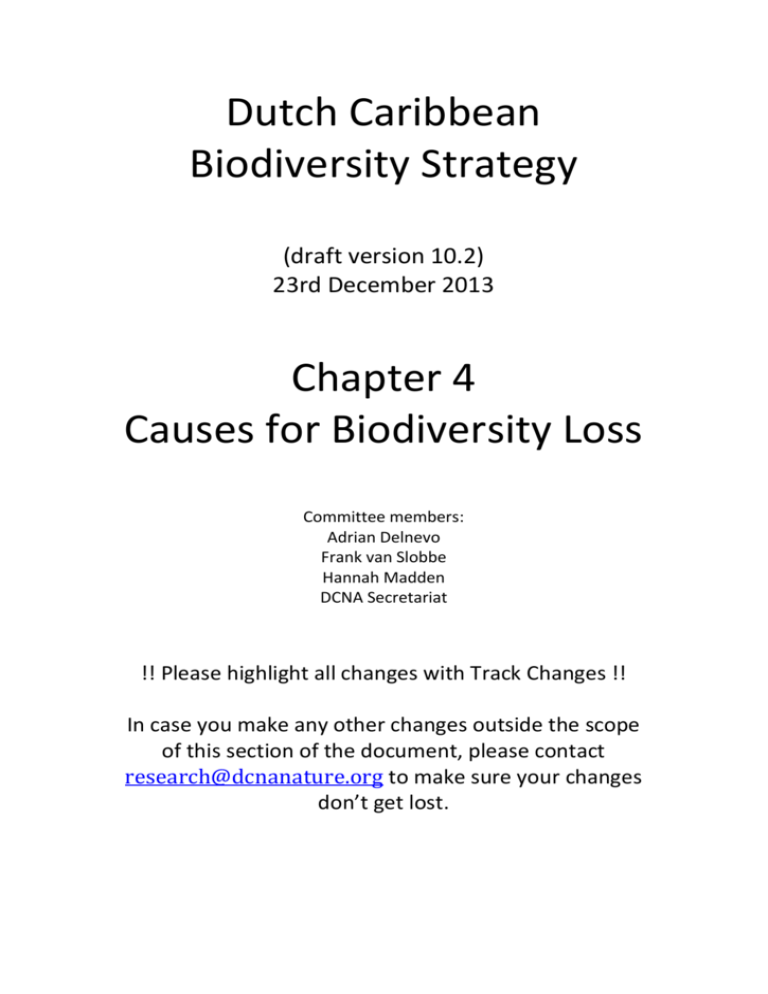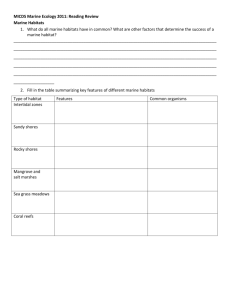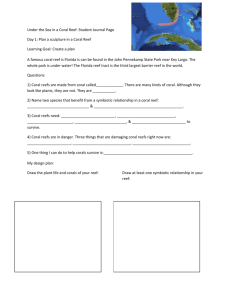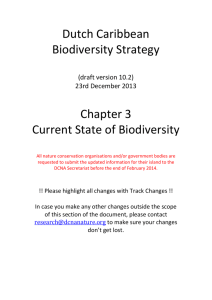Chapter 4. Causes for Biodiversity Loss
advertisement

Dutch Caribbean Biodiversity Strategy (draft version 10.2) 23rd December 2013 Chapter 4 Causes for Biodiversity Loss Committee members: Adrian Delnevo Frank van Slobbe Hannah Madden DCNA Secretariat !! Please highlight all changes with Track Changes !! In case you make any other changes outside the scope of this section of the document, please contact research@dcnanature.org to make sure your changes don’t get lost. 4. Causes of Biodiversity Loss Main Threats In order to preserve biological resources it is necessary to have a clear understanding of the major threats within terrestrial, freshwater and marine systems. Traditionally the identification of threats, such as insufficiently protected areas, illegal trade and poaching, and introduced species has resulted in such actions as greater protection, law enforcement, and non-native eradication programs. All of these responses may be necessary, but they often respond only to part of the problem. More fundamental problems may lie outside protected areas such as pollution, settlement patterns, capital flows and other factors relating to a larger international community. Major threats to biodiversity include: Increased human population and tourism visitation have resulted in increased development, pollution, habitat loss, habitat degradation or fragmentation, and wildlife disturbance Over-harvesting, particularly overfishing, is a chronic threat to ecosystem stability, with species being harvested at a higher rates than they can sustain by natural reproduction Pollution is a complex and all-pervasive issue and includes solid waste management, atmospheric pollution, pollution by agricultural chemicals and pesticides, nutrient and waste water, nitrate and phosphate run-off, salt toxicity, and the release of many compounds of heavy metals from industrial sources such as oil refineries. This has a negative impact not only on terrestrial but also on adjacent marine ecosystems. Climate change is causing a rise in atmospheric and oceanic temperatures resulting in changed weather patterns, bleaching events, sea level rise and ocean acidification. Other predicted impacts include increased storm activity and intensity. The full impacts of global climate change are yet to be determined and the drivers originate far from the areas most strongly affected, such as the small islands of the Dutch Caribbean. Introduced and invasive species, have had a dramatic effect on native flora and fauna around the world, in some instances replacing or out-competing native species. Introduced plants are a serious threat on all the islands and probably represent the pre-eminent threat to terrestrial ecosystems. Introduced and invasive fauna also pose a real and sustained threat to ecosystems such as lionfish in the marine environment, and snakes, rats, cats on land. Moreover, introduced herbivores (e.g., goats, donkeys) threaten native flora and exacerbate habitat degradation. The rapid destruction of the world’s most diverse ecosystems, especially in the tropics, has led many experts to believe that the earth’s total biological diversity is at serious risk of extinction in the next 20-30 years. The definition of rarity is now understood to be more complex than previously envisaged. Understanding the geographic range, habitat specificity and local population size underlies practical conservation biology. Information on threats or ecological stressors will help determine management strategy and subsequent prioritization. Caribbean coral reefs have suffered massive loss of cover. The latest scientific review (Status and Trends of Caribbean Coral Reefs 2013) states ”Coral cover has declined by more than 80% since the 1970s, virtually all the large fishes, sharks and turtles are gone”. The consequences include widespread collapse of coral ecosystems, increase in large seaweeds (macro algae), outbreaks of coral bleaching and disease and failure of corals to recover from natural disturbances such as storms and hurricanes. Major region wide ecological events, which have recently had a negative impact on coral reefs in the Dutch Caribbean include: Mass mortality of sea urchins (Diadema sp) in 1983 White band disease outbreaks 1970s onwards which resulted in massive loss of near shore coral reefs (Acropora sp) Repeated bleaching events and disease outbreaks from1990s onwards Lionfish invasion which effected the Dutch Caribbean from 2010 onwards The signature for overfishing of coral reefs throughout the Caribbean is a long standing feature of the scientific literature whilst the signature for global climate change has only recently become apparent. Protected Area Threats The DCNA Management Success threat classification scheme has been developed using IUCN Red List descriptors, WWF scoring with the inclusion of some detail that has been gathered from conservation practitioners since the start of the Management Success Project in 2004. Six of the most significant threats facing the marine parks of the Dutch Caribbean Threat Detail Invasive; Marine predatory fauna species Lionfish are not native to the Caribbean and seem to have no natural predators in the Caribbean. They are prolific feeders and effective predators. They also reproduce and grow quickly and are resistant to many parasites. The effect their rapidly Waste Water; Sewage Overfishing & harvesting aquatic resources; Intentional (small scale) increasing population will have on the reefs is not yet fully understood. Nutrients are chemicals that are used by plants and animals for growth and energy. The main nutrients used on coral reefs are nitrogen and phosphorus compounds. Sewage from the human population is the main source of nutrient pollution on coral reefs. Corals usually thrive in nutrient poor environments and coral reef ecosystems are designed to quickly recycle any excess nutrients in the system. Any damage to the corals on a reef will affect the whole reef and the human use of the reef e.g. a decline in diving tourism because damaged reefs are less attractive to visitors. Artisanal and recreational fishing is a severe problem where fish and crustacean stocks are directly under threat from local fisherfolk targeting species for consumption and some smaller commercial markets. During heavy rainfall, water runs off the land directly into the marine park. This is especially the case after sustained heavy rain when the ground is soaked and during rain after a dry period when the ground is hard and does not soak up rainfall easily. Terrestrial runoff contains nutrients, sediment litter and pollutants all of which affect the values of the marine environment. Sediment or suspended matter is insoluble particles of soil and other solid inorganic and organic materials that become suspended in water Sedimentation is a Waste Water; Run-off natural process resulting from erosion of land and transport of soil to the sea (terrigenous sediments), or from resuspension of sediment previously deposited (such as carbonate from coral reefs). The main sources of sediment inputs to the marine environment are considered to be runoff and sewage. Agricultural activities, deforestation, urbanisation and poor land management are key human activities that can increase run-off and consequently sedimentation on coral reefs. Building developments for tourism are often carried out near to the water’s edge. This presents particular problems for Residential & pollutants entering marine parks through bad practice. When commercial it is windy or it rains, cement, bags and other site rubbish can development be blown or washed into the sea if preventative steps are not taken. These can then cause considerable damage to coral reef organisms, seagrasses and mangroves. Climate change is often cited as a cause of spiking sea Habitat shifting & temperatures, and a possible cause of increasing annual sea alteration temperatures. Warmer waters absorb more carbon, making them more acidic. Increased temperatures and ocean acidification cause coral bleaching and the attrition of other species with calcareous skeletons. This is changing the structure of coral reefs, reducing coral cover, increasing algae cover and altering reef habitats. Many small open water organisms that form an essential base for the food web; have calcareous skeletons that will also be dissolved in warmer, more acidic seas. Six of the most significant threats facing the marine parks of the Dutch Caribbean Threat Small-holder grazing, ranching or farming Invasive; Terrestrial predatory fauna species Invasive; Terrestrial fauna Invasive; Terrestrial flora Extreme rain Detail Domestic livestock that is allowed to roam and forage in wild habitats, being supported by the resources offered by the parks of the Dutch Caribbean. Goats, sheep, pigs, chickens, donkeys and cows are farmed but not contained. Free roaming animals cause significant damage to park environments cause extensive damage to vegetation on large areas of land. The shrub layer can be reduced to bare soil because of feeding preferences; young shoots are eaten before having a chance to develop and reproduce. Considerable erosion problems develop in heavily grazed areas because there are no roots in the ground to help bind the soil together. Cats, dogs, rats, Boa (Aruba) and mongoose (St. Maarten) effect bird, reptile and other small animal populations by eating adults juveniles and eggs of native and vulnerable species. Domestic livestock that has gone feral (goats, sheep, pigs, chickens, donkeys and cows). There is no record of the numbers of animals and there are no responsible owners. These animals cause significant damage to park environments (see 2.3.2, small-holder grazing). Corallita (also known as Mexican Creeper) is a vine that is often introduced as an ornamental species. It becomes a serious threat to native plants and animals by forming dense impenetrable thickets, smothering the natural vegetation, killing the native species which changes the structure and functions of habitats One of the main environmental consequences of development is erosion. Soil loss due to increased erosion does considerable damage to terrestrial and marine resources, as the eroded material is no longer available for plants to use on land and also reduces water quality and smothers coral reef organisms. The increased water running off the island also contains pollutants such as oil from roads, and fertilisers that directly kill marine organisms. The rainwater does not get the chance to soak into the soil and replenish the groundwater supplies, which dries out soil and stresses remaining plants. Introduced genetic material; Terrestrial fauna The Green Iguana (Iguana iguana) on St. Maarten is thought to be breeding with remaining populations of the Lesser Antillean Iguana (Iguana delicatissima), resulting in hybrid population and loss of the native species. On Saba, it is thought the native species might be a subspecies – a Black Iguana, which is also threatened with hybridisation with other species of Iguana now prevalent on Saba.





